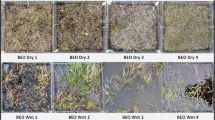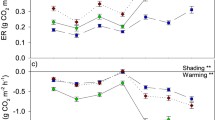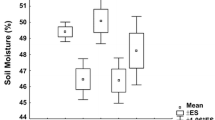Abstract
We conducted plant species removals, air temperaturemanipulations, and vegetation and soil transplants inAlaskan wet-meadow and tussock tundra communities todetermine the relative importance of vegetation typeand environmental variables in controlling ecosystemmethane (CH4) and carbon dioxide (CO2) flux. Plastic greenhouses placed over wet-meadow tundraincreased air temperature, soil temperature, and soilmoisture, but did not affect CH4 or CO2 flux(measured in the dark). By contrast, removal ofsedges in the wet meadow significantly decreased fluxof CH4, while moss removal tended to increaseCH4 emissions. At 15 cm depth, pore-waterCH4 concentrations were higher in sedge-removalthan in control plots, suggesting that sedgescontribute to CH4 emissions by transportingCH4 from anaerobic soil to the atmosphere, ratherthan by promoting methanogenesis. Inreciprocal-ecosystem transplants between thewet-meadow and tussock tundra communities, CH4and CO2 emissions were higher overall in thewet-meadow site, but were unrelated to transplantorigin. Methane flux was correlated with localvariation in soil temperature, thaw depth, andwater-table depth, but the relative importance ofthese factors varied through the season. Our resultssuggest that future changes in CH4 and CO2flux in response to climatic change will be morestrongly mediated by large-scale changes in vegetationand soil parameters than by direct temperature effects.
Similar content being viewed by others
References
Bartlett KB, Crill PM, Sass RL, Harriss RC & Dise NB (1992) Methane emissions from tundra environments in the Yukon-Kuskokwim Delta, Alaska. J. Geophys.Res. 97: 16,645–16,660
Billings WD (1987) Carbon balance of Alaskan tundra and taiga ecosystems: Past, present, and future. Quat. Sci. Rev. 6: 165–177
Billings WD, Luken JO, Mortensen DA & Peterson KM (1982) Arctic tundra: A source or sink for atmospheric carbon dioxide in a changing environment? Oecologia 53: 7–11
Billings WD, Luken JO, Mortensen DA & Peterson KM (1983) Increasing carbon dioxide: Possible effects on arctic tundra. Oecologia 58: 286–289
Bubier JL, Moore TR, Bellisario L, Comer NT (1995) Ecological controls on methane emissions from a northern peatland complex in the zone of discontinuous permafrost, Manitoba, Canada. Global Biogeochem. Cycles 9: 455–470
Chanton JP, Whiting GJ, Showers WJ & Crill PM (1992) Methane flux from Peltandra virginica: Stable isotope tracing and chamber effects. Global Biogeochem. Cycles 6: 15–31
Chapin III FS, Miller PC, Billings WD & Coyne PI (1980) Carbon and nutrient budgets and their control in coastal tundra. In: Brown PC, Tieszen LL & Bunnell FL (Eds) An Arctic Ecosystem: The Coastal Tundra at Barrow, Alaska (pp 458–482). Dowden, Hutchinson, & Ross, Stroudsburg
Chapin III FS, Shaver GR, Giblin AE, Nadelhoffer KJ & Laundre JA (1995) Responses of arctic tundra to experimental and observed changes in climate. Ecology 76: 694–711
Christensen TR (1993) Methane emission from Arctic tundra. Biogeochemistry 21: 117–139
Christensen TR, Jonasson S, Callaghan TV & Havström M (1995) Spatial variation in high-latitude methane flux along a transect across Siberian and European tundra environments. J. Geophys. Res. 100: 21035–21045
Cicerone RJ & Oremland RS (1988) Biogeochemical aspects of atmospheric methane. Global Biogeochem. Cycles 2: 299–327
Denier Van Der Gon HAC & Neue HU (1996) Oxidation of methane in the rhizosphere of rice plants. Biol. Fert. of Soils 22: 359–366
Dise NB (1992) Winter fluxes of methane from Minnesota peatlands. Biogeochemistry 17: 71–83
Epp MA & Chanton JP (1993) Rhizospheric methane oxidation determined via the methyl flouride inhibition technique. J. Geophys. Res. 98: 18,413–18,422
Funk DW, Pullman ER, Peterson KM, Crill PM & Billings WD (1994) Influence of water table on carbon dioxide, carbon monoxide, and methane fluxes from taiga bog microcosms. Global Biogeochem. Cycles 8: 271–278
Happell JD & Chanton JP (1993) Carbon remineralization in a north Florida swamp forest: Effects of water level on the pathways and rates of soil organic matter decomposition. Global Biogeochem. Cycles 7: 475–490
Hobbie SE (1996) Temperature and plant species control over litter decomposition in Alaskan tundra. Ecol. Mon. 66: 503–522
Hu FS, Brubaker LB & Anderson PM (1995) Vegetation and climate change in the Northern Bristol Bay region, Southwestern Alaska. Quaternary Res. 43: 382–392
Hultén E (1968) Flora of Alaska and Neighboring Territories; a Manual of the Higher Plants. Stanford University Press, Stanford CA
IPCC (1995) Climate Change 1995: The Science of Climate Change: Contribution of Working Group I to the Second Assessment Report of the Intergovernmental Panel on Climate Change. Cambridge University Press, Cambridge
IPCC (1995) Climate Change 1995: Impacts, Adaptations and Mitigation of Climate Change: Scientific Technical Analyses: Contribution of Working Group II to the Second Assessment Report of the Intergovernmental Panel on Climate Change. Cambridge University Press, Cambridge
Jähne B, Heinz G & Dietrich W (1987) Measurement of the diffusion coefficients of sparingly soluble gases in water. J. Geophys. Res. 92: 10767–10776
Maxwell B (1992) Arctic climate: Potential for change under global warming. In: Chapin III FS, Jeffries RL, Reynolds JF, Shaver GR & Svoboda J (Eds) Arctic Ecosystems in a Changing Climate: An Ecophysiological Perspective (pp 11–34). Academic Press, Inc., San Diego
Moore TR & Knowles R (1989) The influence of water table levels on methane and carbon dioxide emissions from peatland soils. Can. J. Soil Sci. 69: 33–38
Morrissey LA & Livingston GP (1992) Methane emissions from Alaska arctic tundra: An assessment of local spatial variability. J. Geophys. Res. 97: 16,661–16,670
Nadelhoffer KJ, Giblin AE, Shaver GR & Laundre JA (1991) Effects of temperature and substrate quality on element mineralization in six arctic soils. Ecology 72: 242–253
Oberbauer SF, Cheng W, Gillespie CT, Ostendorf B, Sala A, Gebauer R, Virginia RA & Tenhunen JD (1996) Landscape patterns of carbon dioxide exchange in tundra ecosystems. In: Reynolds JF & Tenhunen JD (Eds) Landscape Function and Disturbance in Arctic Tundra (pp 223–256). Springer, New York
Oberbauer SF, Gillespie CT, Cheng W, Gebauer R, Sala Serra A & Tenhunen JD (1992) Environmental effects on carbon dioxide efflux from the riparian tundra in the northern foothills of the Brooks Range, Alaska. Oecologia 92: 568–577
Oberbauer SF, Tenhunen JD & Reynolds JF (1991) Environmental effects on CO2 efflux from water track and tussock tundra in arctic Alaska, USA. Arctic Alpine Res. 23: 162–169
Oechel WC, Hastings SJ, Vourlitis G, Jenkins M, Riechers G & Grulke N (1993) Recent change of Arctic tundra ecosystems from a net carbon dioxide sink to a source. Nature 361: 520–523
Oechel WC, Vourlitis GL, Hastings SJ & Bochkarev SA (1995) Change in arctic CO2 flux over two decades: Effects of climate change at Barrow, Alaska. Ecol. App. 5: 846–855
Prentice KC & Fung IY (1990) The sensitivity of terrestrial carbon storage to climate change. Nature 346: 48–51
Rouse RW, Holland S & Moore TR (1995) Variability in methane emissions from wetlands at northern treeline near Churchill, Manitoba, Canada. Arctic Alpine Res. 27: 146–156
Schimel JP (1995) Plant transport and methane production as controls on methane flux from arctic wet meadow tundra. Biogeochemistry 28: 183–200
Sebacher DI, Harriss RC & Bartlett KB (1985) Methane emissions to the atmosphere through aquatic plants. J. Env. Qual. 14: 40–46
Seiler W, Holzapfel-Pschorn A, Conrad R & Scharffe D (1984) Methane emissions from rice paddies. J. Atm. Chem. 1: 241–268
Shannon RD, White JR, Lawson JE & Gilmour BS (1996) Methane efflux from emergent vegetation in peatlands. J. Ecol. 84: 239–246
Shaver GR, Billings WD, Chapin III FS, Giblin AE, Nadelhoffer KJ, Oechel WC & Rastetter EB (1992) Global change and the carbon balance of arctic ecosystems. BioScience 42: 433–441
Shaver GR & Chapin III FS (1991) Production: biomass relationships and element cycling in contrasting arctic vegetation types. Ecol. Mono. 61: 1–31
Smith TM & Shugart HH (1993) The potential response of global terrestrial carbon storage to a climate change. Water, Air, Soil Poll. 70: 629–642
Steele LP, Fraser PJ, Rasmussen RA, Khalil MAK, Conway TJ, Crawford AJ, Gammon RA, Masarie KA & Thoning KW (1987) The global distribution of methane in the atmosphere. J. Atm. Chem. 5: 125–171
Tenhunen JD, Gillespie CT, Oberbauer SF, Sala A & Whalen S (1995) Climate effects on the carbon balance of tussuck tundra in the Phillip Smith Mountains, Alaska. Flora 190: 273–283
Torn MS & Chapin III FS (1993) Environmental and biotic controls over methane flux from arctic tundra. Chemosphere 26: 357–368
Vecherskaya MS, Galchenko VF, Sokolova EN & Samarkin VA (1993) Activity and species composition of aerobic methanotrophic communities in tundra soils. Current Microbiol. 27: 181–184
Whalen SC & Reeburgh WS (1988) A methane flux time-series for tundra environments. Global Biogeochem. Cycles 2: 399–409
Whalen SC & Reeburgh WS (1990a) Consumption of atmospheric methane by tundra soils. Nature 346: 160–162
Whalen SC & Reeburgh WS (1990b) A methane flux transect along the trans-Alaska pipeline haul road. Tellus 42: 237–249
Whalen SC & Reeburgh WS (1992) Interannual variations in tundra methane emission: A 4-year time series at fixed sites. Global Biogeochem. Cycles 6: 139–159
Whalen SC, Reeburgh WS & Barber V (1992) Oxidation of methane in boreal forest soils: A comparison of seven measures. Biogeochemistry 16: 181–211
Whalen SC, Reeburgh WS & Reimers CE (1996) Control of tundra methane emission by microbial oxidation. In: Reynolds JF & Tenhunen JD (Eds) Landscape Function and Disturbance in Arctic Tundra (pp 257–274). Springer-Verlag, New York
Whiting GJ & Chanton JP (1992) Plant-dependent methane emissions in a subarctic Canadian fen. Global Biogeochem. Cycles 6: 225–231
Whiting GJ & Chanton JP (1993) Primary production control of methane emission from wetlands. Nature 364: 794–795
Zar JH (1984) Biostatistical Methods. Prentice-Hall, Englewood Cliffs, NJ
Zimov SA, Davidov SP, Voropaev YV, Prosiannikov SF, Semiletov IP, Chapin MC & Chapin FS (1996) Siberian CO2 efflux in winter as a CO2 source and cause of seasonality in atmospheric CO2. Climatic Change 33: 111–120.
Author information
Authors and Affiliations
Rights and permissions
About this article
Cite this article
Verville, J., Hobbie, S., Chapin, F. et al. Response of tundra CH4 and CO2 flux tomanipulation of temperature and vegetation. Biogeochemistry 41, 215–235 (1998). https://doi.org/10.1023/A:1005984701775
Issue Date:
DOI: https://doi.org/10.1023/A:1005984701775




